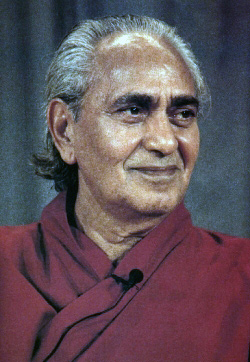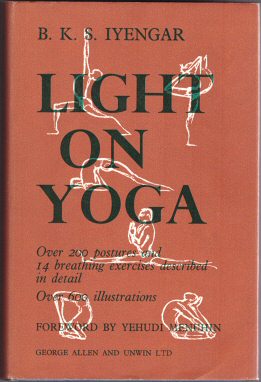
David Frawley, also known as Vamadeva Shastri is an American writer, astrologer, teacher (acharya) and a proponent of Hindutva.

Bellur Krishnamachar Sundararaja Iyengar was an Indian teacher of yoga and author. He is the founder of the style of yoga as exercise, known as "Iyengar Yoga", and was considered one of the foremost yoga gurus in the world. He was the author of many books on yoga practice and philosophy including Light on Yoga, Light on Pranayama, Light on the Yoga Sutras of Patanjali, and Light on Life. Iyengar was one of the earliest students of Tirumalai Krishnamacharya, who is often referred to as "the father of modern yoga". He has been credited with popularizing yoga, first in India and then around the world.

Kriya Yoga is a yoga system which consists of a number of levels of pranayama, mantra, and mudra, intended to rapidly accelerate spiritual development and engender a profound state of tranquility and God-communion. It is described by its practitioners as an ancient yoga system revived in modern times by Lahiri Mahasaya, who claimed to be initiated by a guru, Mahavatar Babaji, circa 1861 in the Himalayas. Kriya Yoga was brought to international awareness by Paramahansa Yogananda's book Autobiography of a Yogi and through Yogananda's introductions of the practice to the West from 1920.
Guru Purnima is a religious festival dedicated to offering respect to all the spiritual and academic gurus. It is celebrated as a festival in India, Nepal and Bhutan by Hindus, Jains and Buddhists. This festival is traditionally observed to honour one's chosen spiritual teachers or leaders. It is observed on the full moon day (Purnima) in the month of Ashadha (June–July) according to the Hindu Calendar. The festival was revived by Mahatma Gandhi to pay tribute to his spiritual guru, Shrimad Rajchandra. It is also known as Vyasa Purnima, for it marks the birthday of Veda Vyasa, the sage who authored the Mahabharata and compiled the Vedas.

The Bihar School of Yoga is a modern school of yoga founded and developed by Sri Swami Satyananda Saraswati in Munger, Bihar, India, in 1963. The system of yoga taught at the Bihar School of Yoga is recognized worldwide as Bihar Yoga or the Satyananda Yoga tradition. In 2019, the Bihar School of Yoga was awarded the Prime Minister’s Award for Outstanding Contribution Towards Promotion and Development of Yoga.

Amrit Desai is a pioneer of yoga in the West, and one of the few remaining living yoga gurus who originally brought over the authentic teachings of yoga in the early 1960s. He is the creator of two brands of yoga, Kripalu Yoga and I AM Yoga, and is the founder of five yoga and health centers in the US. His yoga training programs have reached more than 40 countries worldwide and over 8,000 teachers have been certified.

Swami Rama was an Indian yoga guru. He moved to the US in 1969, initially teaching yoga at the YMCA, and founding the Himalayan Institute of Yoga Science and Philosophy in Illinois in 1971; its headquarters moved to its current location in Honesdale, Pennsylvania in 1977. He became famous for his ability to control his body in yoga nidra, writing many books including the autobiographical Living with Himalayan Masters. From the 1970s onwards, there were persistent allegations of sexual abuse of his followers; in 1997 a woman won a lawsuit against him for multiple sexual assaults.
Barbara Stoler Miller was a scholar of Sanskrit literature. Her translation of the Bhagavad Gita was extremely successful and she helped popularize Indian literature in the U.S. She was the president of the Association for Asian Studies in 1990.

Swami Nigamananda Paramahansa was an Indian yogi, guru and mystic in Eastern India. He is associated with the Shakta tradition and a spiritual master of vedanta, tantra, yoga and prema or bhakti. His followers referred him as Thakura.

The Yoga Institute is a government recognized non-profit organisation, known as the oldest organized yoga center in the world. It was founded in 1918 by Shri Yogendra (1897-1989), who was one of the important figures in the modern revival of yoga. It is headquartered in Santacruz, Mumbai, India.

Swami Kuvalayananda was a yoga guru, researcher, and educator primarily known for his pioneering research into the scientific foundations of yoga. He started research on yoga in 1920, and published the first journal specifically devoted to studying yoga, Yoga Mimamsa, in 1924. Most of his research took place at the Kaivalyadhama Health and Yoga Research Center at Lonavla which he founded in 1924. He has had a profound influence on the development of yoga as exercise.

Vishwas Mandlik, better known as Mandlik sir, was the founder of the "Yoga Vidya Dham" and is considered one of the foremost yoga teachers in India. He has written many books on yoga practice and philosophy. On 6 March 2007, Paramhansa Niranjananda Saraswati of Bihar Yoga, initiated him to Rushi Sannayasa and gave new name Rushi Dharmajyoti.
Sadashiv Prahlad Nimbalkar was an Indian academic, author, Yoga guru and the founder of Yoga Vidya Niketan (YVN), a Mumbai-based Yoga institute, promoting the practice of Yoga. A former physical education instructor and a vice principal of a junior college, Nimbalkar practiced Yoga under renowned teacher, Swami Kuvalayananda, one of the pioneers of Yoga research and the founder of Kaivalyadhama Yoga Institute. Yoga Vidya Niketan, the institute Nimbalkar founded, offers various courses such as Diploma in Yogic Science, Teachers Training Courses, Diploma in Yoga Therapy and Diploma in Natural Living and Naturopathy, for students and teachers.

Barkha Sharma is an Indian fashion designer, classical dancer, author, and co-founder of the men's clothing label Barkha 'n' Sonzal. In 2014, she was nominated to represent India in the International Woolmark Prize in the menswear category. Barkha, under the label Rhydhun, also designs handicrafts. She is a trained dancer and tanpura player who was invited to perform with her husband Rahul Sharma for Prince William and Kate Middleton at the Hyderabad House, in the presence of the Prime Minister of India Narendra Modi in April 2016. Barkha is the author of “Global Little Yogis,” a book about making yoga and wellness a regular part of one's routine.

Manibhai Haribhai Desai, known as (Shri) Yogendra was an Indian yoga guru, author, poet, researcher and was one of the important figures in the modern revival and transformation of Hatha Yoga, both in India and United States. He was the founder of The Yoga Institute, the oldest organized yoga centre in the world, established in 1918. He is often referred as the Father of Modern Yoga Renaissance. He was one of the figures responsible for reviving the practice of asanas and making yoga accessible to people other than renunciates.

Dr. Jayadeva Yogendra (1929–2018) was an Indian yoga guru, researcher, author, educator and president of The Yoga Institute, the oldest organized yoga center in the world, founded by Yogendra in 1918. Dr. Yogendra was known for studies on therapeutic effects of Yoga. He pioneered yoga education and has written several books on the therapeutic effects of the ancient science, including Yoga Therapy in Asthma, Diabetes, Heart Disease and Yoga Sutras of Patanjali.

Light on Yoga: Yoga Dipika is a 1966 book on the Iyengar Yoga style of modern yoga as exercise by B. K. S. Iyengar, first published in English. It describes more than 200 yoga postures or asanas, and is illustrated with some 600 monochrome photographs of Iyengar demonstrating these.

Yoga as exercise is a physical activity consisting mainly of postures, often connected by flowing sequences, sometimes accompanied by breathing exercises, and frequently ending with relaxation lying down or meditation. Yoga in this form has become familiar across the world, especially in the US and Europe. It is derived from medieval Haṭha yoga, which made use of similar postures, but it is generally simply called "yoga". Academics have given yoga as exercise a variety of names, including modern postural yoga and transnational anglophone yoga.

Postural yoga began in India as a variant of traditional yoga, which was a mainly meditational practice; it has spread across the world and returned to the Indian subcontinent in different forms. The ancient Yoga Sutras of Patanjali mention yoga postures, asanas, only briefly, as meditation seats. Medieval Haṭha yoga made use of a small number of asanas alongside other techniques such as pranayama, shatkarmas, and mudras, but it was despised and almost extinct by the start of the 20th century. At that time, the revival of postural yoga was at first driven by Indian nationalism. Advocates such as Yogendra and Kuvalayananda made yoga acceptable in the 1920s, treating it as a medical subject. From the 1930s, the "father of modern yoga" Krishnamacharya developed a vigorous postural yoga, influenced by gymnastics, with transitions (vinyasas) that allowed one pose to flow into the next.

Modern yoga gurus are people widely acknowledged to be gurus of modern yoga in any of its forms, whether religious or not. The role implies being well-known and having a large following; in contrast to the old guru-shishya tradition, the modern guru-follower relationship is not secretive, not exclusive, and does not necessarily involve a tradition. Many such gurus, but not all, teach a form of yoga as exercise; others teach forms which are more devotional or meditational; many teach a combination. Some have been affected by scandals of various kinds.




















